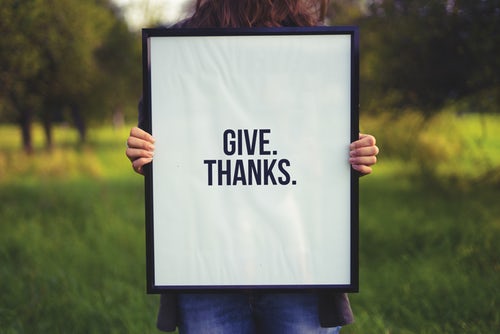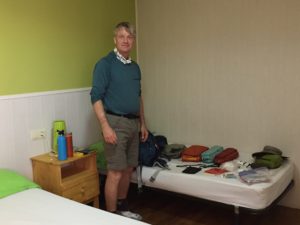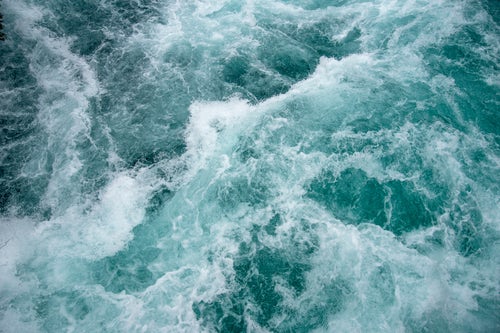The afternoon and evening routine continued nearly everyday. And we grew to appreciate it.
Just as the repetition of the morning preparation to hit the road and walk for four, five or six hours prepared us for the day, the evening repetition helped us recover from the hiking and rejuvenate for the next day. The line-up almost sounds like a reverse of the morning preparation I explained last Friday.
Afternoon and evening rituals—
- Arrive at the city you’ve decided to walk to and locate the albergue, pension, hostel or hotel you plan to stay in, or have made reservations with.
- Check in, show them your pilgrim credentials for the official stamp, show them your U.S. passport for identification, pay and locate your room and bed.
- Be given the ten-minute spiel about requirements at this particular location: where to deposit your dusty shoes, do and hang your laundry, location for dinner and/or breakfast if they provide it and you’ve paid for it.
- Peel off your dripping clothes, take a much-needed shower, change into clean, dry clothes and put on compression socks and sandals. Make sure you check your feet and toes for blisters and attend to anything that looks as though it may become a problem. Trim nails, sand down encroaching calluses, etc.
- Wash and dry, or hang, your clothes to dry.
- Lie down and put your legs up for a while to reduce the swelling and give them a break. See if you can get a leg massage from your beloved hiking partner! Grab a snack if you want, and since it’s likely to be another four to five hours before dinner. Take this time to journal the day’s events and impressions. A nap was another enjoyable event.
- Decide what local churches or sites you want to visit and pad around for a couple of hours as pilgrim-tourists.
- Show up on time at the place where the local peregrino dinner is served, meet other pilgrims, and enjoy a lengthy fresh and delicious (no preservative, often fresh out of the garden) meal. Three courses for one low price, of course!
- Return to your room and prepare for bed: brush teeth, put on your sleeping attire, make sure you’ve got what you for the next day laid out under your bed or on a table and have packed what you don’t think you’ll be using. If your joints and legs are aching, take an anti-inflammatory or rub a topical anti-inflammatory on them.
- Lock all valuables in the available locker.
- Lay out your silk sleeping bag and/or sleeping bag liner and any provided blanket, turn out the lights and say your prayers. (Lights out was always by 10:00 PM. Alburgue requirement.
Unexpected benefits—
You’d think this would get old. It didn’t. While we didn’t necessarily develop a relish for living like vagabonds out of our backpacks or sleeping in a different bed every night, the mundane routine provided us with an extraordinary benefit we hadn’t expected.
It cleared our brain for experiencing and focusing on impactful places, events and people.
Our brains were stimulated by the changing terrain and weather, the different languages we heard spoken as we walked, the people we met, the interesting conversations we shared with them and one another, each new church we toured and sat in daily to breathe in history, faith-through-the ages, and God’s spirit.
And it only took two days of hiking for my brain to release the unimportant baggage and celebrate its liberation.
How my normally busy brain responded—
Sitting in the 13thcentury church in Roncesvalles, listening to the Gregorian chants drifting through the nave, I suddenly realized just how relaxed I was. I wasn’t daydreaming. I didn’t have to wrest my thoughts from a lengthy to-do list, other places I should be. No guilt tormented me for not partaking in some other activity that might seem more important, might make someone else happy, might give a leg-up and edge in life.
Instead, I sat and inhaled deeply of the dampness. The dim light enhanced the relaxed state of my body and mind. But the realization that I could—and was—experiencing such peace ignited a spark of joy in my soul.
And more—
Several days later another revelation hit me: I could remember everything I had eaten for breakfast, lunch and dinner, and remembered what I had done, where I had stayed, the names of the pilgrims I had met and talked with, all the details of every day of my pilgrim journey without having to wade through brain file cabinet of incidental distractions and information. And I was stricken with a bout of giddiness.
It wasn’t my age or health causing me to have foggy-brain forgetfulness. It was my lifestyle bogging down my brain. My lifestyle that caused me to live my life in a fog.
It was then that I vowed to never return to the same-old, same-old when I returned home, no matter how hard life and the world tried to shove me back on that overloaded path.
As we did on the Camino, I vowed to chew on life slowly, savior it like the delicacy that it is.
Keeping it going—
I know it will sometimes be a fight, and that I’ll often have to take a stand. But how could I knowingly and willingly re-cloak myself in harriedness when I had gone through such pains to cast it off?
Certainly there will be stressful moments in my life. That’s unavoidable. But when the stress comes now, which it will without warning, I am more likely to withstand it, analyze it appropriately and take effective steps to diffuse or deal with it. I am not so overwhelmed with life and its events that I am paralyzed by indecision or lack of direction.
Now I can understand why so many want to return to the Camino—The Way—over and over again. Five, six or more trips. Some return to recover what they lost. Others return in an attempt to attain what they never found. Still others repeat the walk to keep the change going, like a refresher course to keep your daily life responses on par with what you learned the first time, the way you want it to always be.
The future—
For us, we can’t wait to return to finish what we started, to keep the feelings and experiences going. To instill and deepen the lessons learned.
People said it would be life changing. I didn’t doubt them for a second.
Now I know just how life changing it can be.
Several Fridays ago I promised to give you some concrete ways I’m making sure we’re staying on track with the new normal. We’ll cover that next week.
Until then, take some time to just sit still this weekend, shut out the concerns and pressures and take in the simple pleasures of your surroundings. Don’t think about or worry about where you’re not; focus on where you are.
Blessings,
Andrea
May you prosper in all things and be in health, just as your soul prospers (3 John 2).



 When you’re preparing to leave one place you know you won’t be returning to and walking 5 – 15 miles to another location, you plan carefully. You spend some time thinking about what you’re going to wear, how you’re going to pack, in case the weather changes and you need to shed a jacket or get to your rain gear and poncho in a hurry. If you happen to leave something back at the place you slept, you think long and hard about whether you really need it. About whether or not you can buy a replacement in the next tiny village you sleep in.
When you’re preparing to leave one place you know you won’t be returning to and walking 5 – 15 miles to another location, you plan carefully. You spend some time thinking about what you’re going to wear, how you’re going to pack, in case the weather changes and you need to shed a jacket or get to your rain gear and poncho in a hurry. If you happen to leave something back at the place you slept, you think long and hard about whether you really need it. About whether or not you can buy a replacement in the next tiny village you sleep in.

